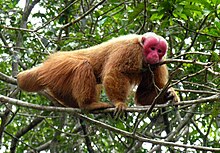Uakari: Difference between revisions
m Undid revision 382082073 by 199.17.46.123 (talk) |
|||
| Line 33: | Line 33: | ||
==Species== |
==Species== |
||
There are four species in this genus:<ref name=msw3/><ref name=Boubli2008>{{cite journal | author = Boubli, J. P., M. N. F. da Silva, M. V. Amado, T. Hrbek, F. B. Pontual, and I. P. Farias | year = 2008| title = A taxonomic reassessment of black uakari monkeys, Cacajao melanocephalus group, Humboldt (1811), with the description of two new species | journal = International Journal of Primatology | volume = 29| pages = 723–749 | doi = 10.1007/s10764-008-9248-7}}</ref> |
|||
* Genus ''Cacajao'' |
* Genus ''Cacajao'' |
||
** [[Bald Uakari]] or Red Uakari, ''C. calvus'' |
** [[Bald Uakari]] or Red Uakari, ''C. calvus'' |
||
Revision as of 02:43, 2 September 2010
| Uakari[1] | |
|---|---|

| |
| Bald Uakari (Cacajao calvus) | |
| Scientific classification | |
| Kingdom: | |
| Phylum: | |
| Class: | |
| Order: | |
| Family: | |
| Subfamily: | |
| Genus: | Cacajao Lesson, 1840
|
| Type species | |
| Simia melanocephalus Humboldt, 1812
| |
| Species | |
|
Cacajao melanocephalus | |
Uakari is the common name for the New World monkeys of the genus Cacajao. Both the English and scientific names are believed to have originated from indigenous languages.[2]
The uakaris are unusual among New World monkeys in that the tail length (15-18 cm) is substantially less than their head and body length (40-45 cm). Their bodies are covered with long, loose hair but their heads are bald. They have almost no subcutaneous fat, so their bald faces appear almost skull like. Like their closest relatives the saki monkeys, they have projecting lower incisors.
The four species of uakari currently recognized are all found in the north-western Amazon Basin. The Bald Uakari is found north of the Amazon River, and south of the Japurá River in the Mamirauá Sustainable Development Reserve. The Black-headed Uakari is found north of the Amazon and south of the rio Negro. The Neblina Uakari is found north of the rio Negro, west of the rio Marauiá and east of the Casiquiare canal. The Ayres Uakari is currently known only from the rio Curuduri basin.
Uakaris are typically lethargic and silent in zoo conditions, but in the wild they are agile and active, capable of leaps of over 6 meters.[citation needed] They have been observed both in small groups and in larger troops of up to 100. When traveling through the forest they move in the lower branches of the trees, though when foraging they also go up to the canopy. They eat fruit, nuts, buds and leaves.[citation needed]
Henry Walter Bates, the nineteenth century zoologist, recorded that the Native Americans captured uakaris alive by using blowpipe darts or arrows tipped with diluted curare; once captured the animals were revived by putting a pinch of salt in their mouths. Those animals that survived were kept as pets.[citation needed]
Species
There are four species in this genus:[1][3]
- Genus Cacajao
- Bald Uakari or Red Uakari, C. calvus
- Cacajao calvus calvus
- Cacajao calvus ucayalii
- Cacajao calvus rubicundus
- Cacajao calvus novaesi
- Black-headed Uakari, Cacajao melanocephalus
- Aracá Uakari, Cacajao ayresi*
- Neblina Uakari, Cacajao hosomi*
- Bald Uakari or Red Uakari, C. calvus
*Newly described species.[3]

References
- ^ a b Groves, C. P. (2005). Wilson, D. E.; Reeder, D. M. (eds.). Mammal Species of the World: A Taxonomic and Geographic Reference (3rd ed.). Baltimore: Johns Hopkins University Press. p. 146. ISBN 0-801-88221-4. OCLC 62265494.
- ^ Barnett, A. A. (2004). The meanings of Cacajao and Uacari: Folk Etymology in Neotropical Primate Taxonomy. Neotropical Primates 12(3): 147-152
- ^ a b Boubli, J. P., M. N. F. da Silva, M. V. Amado, T. Hrbek, F. B. Pontual, and I. P. Farias (2008). "A taxonomic reassessment of black uakari monkeys, Cacajao melanocephalus group, Humboldt (1811), with the description of two new species". International Journal of Primatology. 29: 723–749. doi:10.1007/s10764-008-9248-7.
{{cite journal}}: CS1 maint: multiple names: authors list (link)
